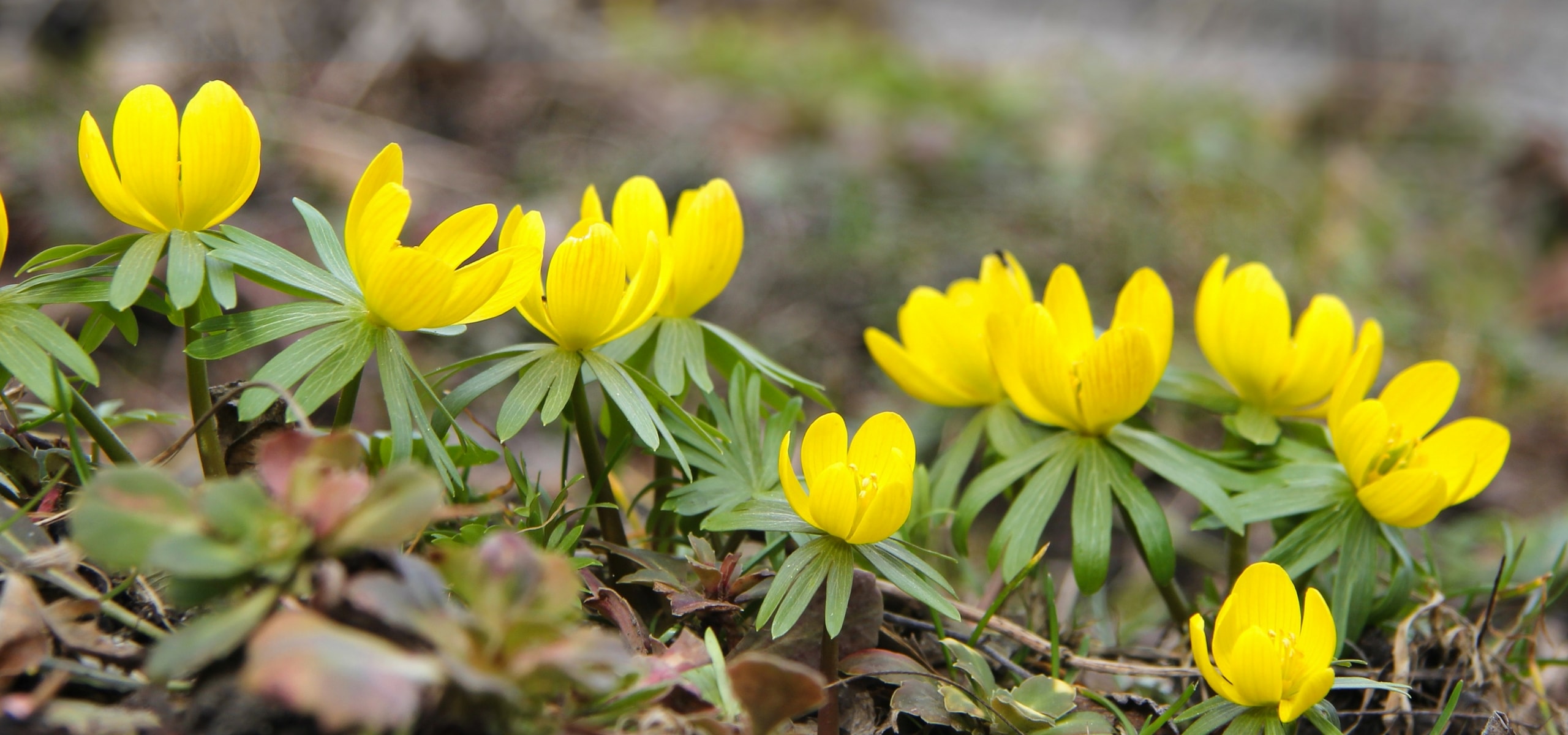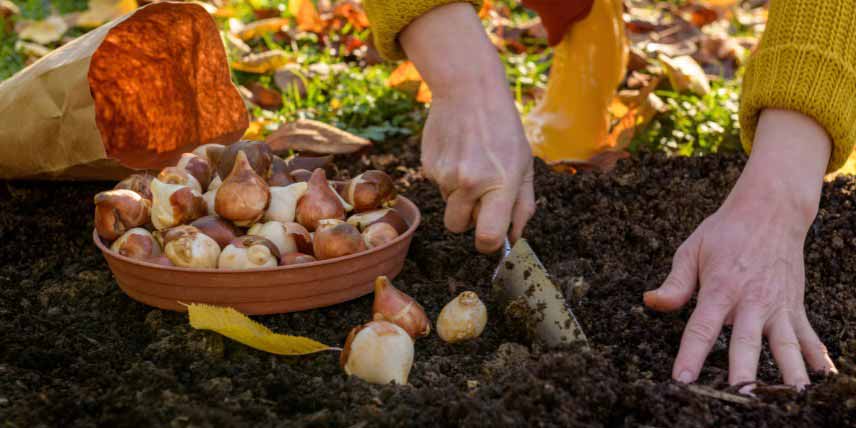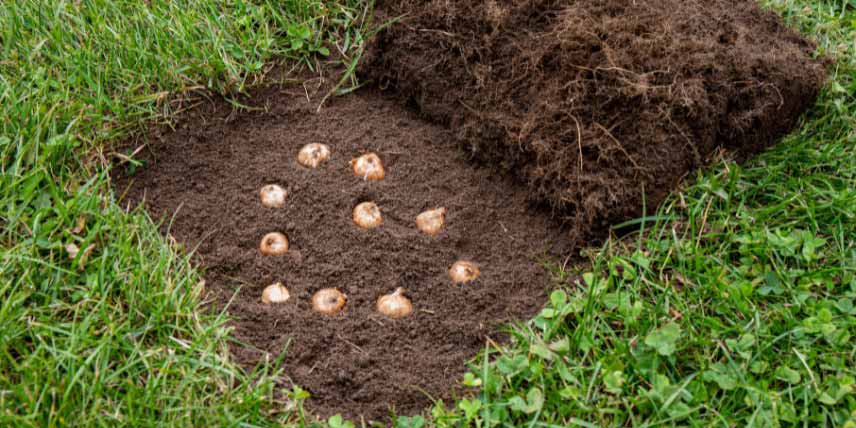
Planting spring-flowering bulbs
All our tips for successfully planting them in the garden
Contents
Spring-flowering bulbs are invaluable for bringing colour and life to the garden from the very first days of spring! Tulips, daffodils, crocuses, and hyacinths: these easy-to-grow flowers provide a stunning display after the winter months. To enjoy a generous flowering, it is essential to choose their location wisely, prepare the soil, and follow a few simple planting and maintenance rules. We guide you step by step to successfully grow your spring bulbs!
→ Also discover our planting tips in our audio podcast:
Where to plant spring bulbs?
Most spring flowering bulbs, such as tulips, crocuses, and hyacinths, prefer full sun exposure. A good amount of direct light stimulates their flowering and promotes healthy growth. However, some more tolerant varieties, such as daffodils and fritillaries, also thrive in partial shade, especially if they receive at least some afternoon sun. Observe the sunlight in your garden at different times of the day to choose the ideal spot. A location that receives at least 4 to 6 hours of sun per day is recommended for these bulbs.
There are, however, exceptions. Some species, often woodland bulbs, prefer shadier areas. These varieties include Camassias, Erythroniums, scillas (Scilla nutans and Scilla siberica), Eranthis hyemalis, and wood anemones. They adapt well to shaded or semi-shaded areas of your garden, such as the base of trees or sheltered spots in hedges.
Flowering bulbs are particularly sensitive to excess moisture, especially during winter, as this can lead to rot. That is why it is crucial for the soil to be well-drained. Bulbs thrive in loose, airy soils where water drains easily. They also do well on slightly sloped ground or even in pot culture, as this helps prevent water stagnation.
If your soil is heavy (clay) or very humus-bearing (like woodland soil), it may tend to retain moisture. In this case, it is advisable to mix sand or fine gravel into the garden soil to improve drainage and lighten the soil. This helps the roots of the bulbs breathe and reduces the risk of rot.
Read also
Bulb sizes: how to choose?When to plant them?
Spring-flowering bulbs are planted in autumn, between September and November, before the first frosts. This period allows the bulbs to root before winter, taking advantage of the cool temperatures. Plant them about 4 to 6 weeks before the frost to give them time to develop their roots. In regions with mild winters, you can extend planting until December, as long as the soil is not frozen. Timely planting ensures a beautiful flowering in spring!
How to plant them?
- Dig a hole approximately 3 to 5 times the height of the bulb. Larger bulbs (like tulips) should be planted deeper, while smaller ones (like crocuses) can be placed closer to the surface.
- Fill the bottom of the hole with a mix of garden soil and potting soil, possibly adding coarse sand for drainage, then lightly compact it.
- Place the bulbs in the hole, point up and roots down. Make sure to space them at least half their width apart to avoid crowding as they grow.
- Once the bulbs are positioned, cover them with soil until they are buried under 2 times their height of soil. Lightly compact it.
- If your soil is dry, water (moderately) to help the bulbs establish roots.
 Tulip bulb planting[/caption>
Tulip bulb planting[/caption>
Mass planting techniques
- For a spectacular effect, plant your bulbs in mass, with about 80 to 150 bulbs per square metre depending on the varieties. A practical method is to excavate the entire area to be planted, arrange the bulbs, then backfill the soil over the whole area.
- If you want to plant bulbs in a short grass meadow, use the same method: cut out patches of turf, arrange your bulbs, then replace the turf on top. They will grow through the meadow in spring.
- For a more natural look, mix different varieties of bulbs in a basket before planting. This will create varied and spontaneous flowering.
Don’t forget to mark your planting areas to avoid damaging them during winter gardening work.
 Planting in a short grass meadow[/caption>
Planting in a short grass meadow[/caption>
Read also
6 bulbs easy to naturalise in the gardenHow to care for bulbs after flowering?
Once flowering is over, you can cut the faded flower stems to prevent the plant from dedicating too much energy to seed production. This allows the bulb to concentrate its resources on replenishing its reserves.
However, it is essential to leave the leaves in place until they turn yellow and completely dry out. The leaves continue to produce energy through photosynthesis, which nourishes the bulb for its future flowering. Only cut them when they are fully dried out, often several weeks after the end of flowering.
You can also apply a bulb fertiliser just after flowering. A nutrient boost at this time will help the bulb strengthen its reserves for the following spring. Choose a fertiliser rich in potassium and phosphorus.
Finally, in particularly rainy areas or if your bulbs are planted in pots, be careful not to overwater after flowering to prevent them from rotting. Allow the bulbs to rest and enter dormancy until the next growth season.
- Subscribe!
- Contents






























